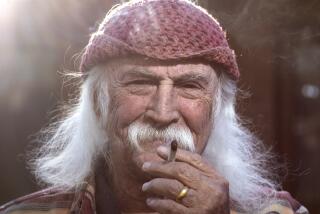Museum rankles Bing Crosby’s kin
- Share via
RENO -- Bing Crosby lassoed the hearts of locals as the proud owner of seven ranches around Elko, Nev., at the height of his showbiz career in the 1940s and ‘50s.
The crooner, best known for “White Christmas” and the “road” movies he made with Bob Hope, was named Elko’s honorary mayor in 1948. He donated thousands of dollars to local causes, gave occasional free performances and put Elko on the map by having the city host the 1951 premiere of his film “Here Comes the Groom.”
Thirty years after his death, angry family members and friends are accusing Elko’s Northeastern Nevada Museum of disrespecting his legacy by drastically scaling back its Crosby exhibit.
Crosby’s niece Carolyn Schneider said the museum had the second-largest public Crosby memorabilia collection in the country until it was dismantled last summer. Gonzaga University in Crosby’s hometown of Spokane, Wash., has the largest.
While the crooner’s widow, Kathryn Crosby, did not wish to publicly comment, she privately expressed disappointment over the museum’s action, Schneider said.
“To take that away from him is very unfair. It diminishes his show business career and importance to Elko and Elko County,” said Schneider, author of “Me and Uncle Bing.”
Hobie Wilson, president of the Bing’s Friends and Collectors Society, said the museum’s move was insulting: “[It] was a slap in the face to Crosby fans all over the world. It’s like they’re sitting on the man’s grave.”
Museum Director Claudia Wines acknowledges Crosby’s contributions to the mining and ranching town about 300 miles east of Reno. But she said the museum’s mission is to feature items from the region, and she won’t reconsider the decision to only show memorabilia from Crosby’s Elko days.
The museum had expanded its Crosby exhibit in 2004 after Schneider donated about 30 items unrelated to his time in Elko. Included were photos of Crosby’s home in Pebble Beach, Calif., a set of monogrammed bed linens, sheet music, record albums, Christmas cards and newspaper articles.
A new Crosby exhibit, which opened this fall, is about one-quarter the size of the old one, Wines said. It includes photos of Crosby in Elko, a branding iron from one of his ranches, a trophy he donated to a local rodeo and a denim tuxedo said to have been presented to Crosby.
“It’s not like the rest of his life is being ignored. There are other places that tell the rest of the story,” Wines said.
“In retrospect, we shouldn’t have gone to the bigger exhibit. It wasn’t the smart thing to do because it went against our mission of telling the story about northeastern Nevada.”
Kathleen Oldham Taylor, 69, a member of a longtime Elko County ranching family, said she supports the museum’s decision. Her father, a real estate agent, became a close Crosby friend after selling ranches to the entertainer.
“Bing sang me to sleep many a night and was such a fine man,” Taylor said. “He enjoyed his privacy and laid-back life out here, and he would be as embarrassed as hell over this. He wouldn’t think it’s a big deal what the museum has done.”
Crosby was one of the most popular entertainers of the 20th century, a huge star on stage, radio, movies and television. His recording of “White Christmas” was for decades the biggest-selling single of all time. He won the 1944 best actor Oscar for “Going My Way.” His role in the 1936 movie “Rhythm on the Range” is credited for fueling his interest in the cowboy life and the Old West.
He became a familiar sight on the streets of Elko, wearing faded blue jeans and a straw hat while he owned a succession of ranches around Elko from 1943 to 1958.
The town was an escape from the pressures of Hollywood for Crosby, who enjoyed ranching, fishing and hunting, Schneider said. And he appreciated that the locals treated him as a “regular guy.”
Crosby visited Nevada each summer with his four sons by his marriage to his first wife, Dixie Lee, and paid them cowhand wages to work on the ranches. He sold the ranches after his sons expressed no interest in continuing the operations.
Dixie Lee died in 1952; all four sons also have since died. Crosby died at age 74 on a golf course in Spain in October 1977.
The exhibit has been moved from a back room to the museum’s main gallery where more people will be able to see it, Wines said.
More to Read
The biggest entertainment stories
Get our big stories about Hollywood, film, television, music, arts, culture and more right in your inbox as soon as they publish.
You may occasionally receive promotional content from the Los Angeles Times.










